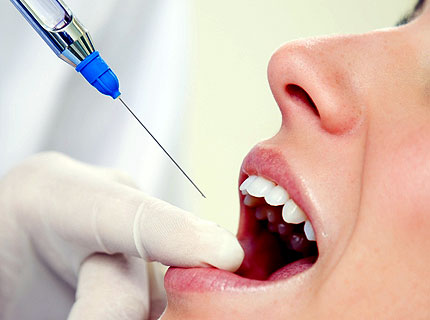Local Anesthesia (or Local Anaesthesia) is one of the frequently used combination in the Dental clinics where several treatment procedures are preceded with the injection of Local Anesthesia for the anesthesia / numbness of that certain part of the oral cavity where the treatment is going to be done. The Local Anesthetic agent has got several components in itself, which does the job of anesthetizing the area while maintaining a proper blood pressure, controlling bleeding and keeping itself less irritant to the tissues of the body.
Following are the components in the Local Anesthesia:
- Local anesthetic drug
- Vasopressor/vasoconstrictor drug
- Preservative for vasopressor
- Sodium chloride (NaCl) or Ringer’s solution
- Distilled water
- General preservatives
Local Anesthetic Drug
This component provides pain control during dental therapy. It interrupts propagation of impulse preventing it from reaching brain through one of the various mechanisms of actions based on the chemical present in the drug. Drugs are listed by their percentage (%) concentration. The number of mg of an agent contained in the cartridge can be calculated by multiplying the percentage (%) concentration (e.g. 2% = 20 mg/ml) by 2 (the number of ml in a cartridge). Thus, a cartridge containing 2 ml of 2% local anesthetic solution contains 40 mg of local anesthetic agent.
The local anesthetic solution is quite stable, capable of being autoclaved, heated or boiled without deterioration. However, other contents of cartridge, such as Vasopressor and cartridge seal are more labile. These are broken down easily.
In India, the Local anesthetic solutions with the Adrenaline vasoconstrictor is available in the ratio of 1:180,000 and 1:200,000 and in these following are the amounts of Lignocaine hydrochloride LA agent available:
- LA 1:180,000 ratio has 24.64mg of Lignocaine hydrochloride (2%)
- LA 1:200,000 ratio has 21.30mg of Lignocaine hydrochloride (2%)
Vasopressor / Vasoconstrictor Drug
It is added in various concentrations, to some dental cartridges and it has got several roles in the LA agent, as following:
- Increase safety of the Local Anesthesia
- Prolong the duration of action of local anesthetic agents
- Helps in controlling bleeding
The pH of dental cartridge containing local anesthetic agent with a vasoconstrictor is lower (more acidic) than that without a vasoconstrictor (pH of 3.3-4.0 v/s 5.5-6.0). Because of this pH difference plain anesthetics have somewhat more rapid or clinical action and are more comfortable (less burning on injection).
One of the common vasoconstrictors is Adrenaline bitartarate and its concentration is:
- Adrenaline in LA ratio 1:180,000 – 0.0125mg
- Adrenaline in LA ratio 1:200,000 – 0.0005mg
Preservative for Vasoconstrictor
Local anesthetic solutions containing Vasoconstrictors also contain a specific agent, an antioxidant, that acts as a preservative for vasoconstrictors. The most frequently used antioxidant is Sodium bisulfite or Sodium metabisulfite. It prevents biodegradation of vasopressor by oxygen which might be present in the cartridge either introduced during manufacturer, or which got diffused through semipermeable membrane or the rubber diaphragm after filling at the time of storage of the cartridge. The Sodium bisulfite reacts with oxygen before oxygen can destroy the vasopressor. Sodium-bisulfite is oxidised to sodium-bisulphate, a chemical with even lower pH (acidic) than before oxidation and this thus would increase the life of the LA agent.
The amount of Sodium bisulfite in the LA agent of 1:180,000 ratio is 0.4mg while that in the 1:200,000 ratio is 0.5mg.
A tip for usage of LA cartridge –
There is increased burning (discomfort) upon injection of an “older” cartridge with a vasopressor than with a fresher cartridge and thus once the cartridge container is opened, it should be used within a reasonable time. Local anesthetic solutions without vasoconstrictors have a shelf-life of about 48 months. Local anesthetic solutions containing vasoconstrictors have their shelf-life reduced to 18 and 12 months for epinephrine and phenylephrine; and norepinephrine and levonordefrine, respectively. This is so because of the instability of the vasoconstrictors. Hence fresh solutions produce better analgesia and cause less irritation to the tissues. Allergy to Bisulfites must be considered in pre-anesthetic medical evaluation.
Isotonic Medium – Sodium chloride (NaCl) or Ringer’s solution
It is added to the contents of dental cartridge to make the solution isotonic with the tissues of the body. Hypertonic solution produces tissue edema, paresthesia, sometime lasting for several months following drug administration. Around 0.29ml of Ringer’s solution is added to the LA agent, and the remaining volume is filled up by the diluent.
Diluent – Distilled water
It is used as a diluent to provide the volume of solution in the dental cartridge.
Preservatives
A number of chemicals are used as general preservatives. These are added to increase the shelf-life and these include – (i) Methylparaben, (ii) Thymol, and (iii) Chlorbutol
- Methylparaben: It is a Bacteristatic and Fungistatic agent. It has been excluded from cartridges in USA, from 1st January 1984, following reports of allergy. However, it is still used in multidose vials in some countries including India.
- Thymol: It is Antiseptic, Fungistatic, Antihelminthic.
- Chlorbutol: It is Antibacterial and Antifungal, and about 5mg is added in a single cartridge of LA.
Note: This composition was taken from Manual of Local Anesthesia in Dentistry by AP Chitre

what do you understand by endodontics treatment?